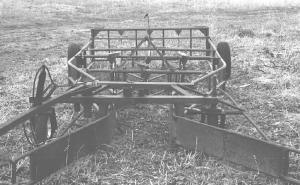1997 - Volume #21, Issue #4, Page #09
[ Sample Stories From This Issue | List of All Stories In This Issue | Print this story
| Read this issue]
Redesigned Bale Accumulator "Works Great"
 |
The original accumulator was designed to be pulled behind the baler and had a center-mounted pivot wheel on front. Bales slid down a 2-ft. long chute above the wheel into a series of gates that automatically tripped to position eight small square bales into two rows of four. However, the automatic trip mechanism didn't work very well so he changed it to a manual system that works by pulling on a rope connected to a lever. He also added an offset hitch and a pair of 5-ft. long bale guides on front, and an axle and wheels on back.
"I like the design of this machine a lot be-cause it doesn't have chain drives or hydraulics to maintain," says Jones. "The last bale in trips the back gate to release the stack. An unexpected advantage is that I can now line up 15 or 20 stacks in a straight line which allows me to load them a lot faster. It works fast. It takes only about 45 minutes to load 400 bales onto two trucks and trailers. By using two loaders - one at the barn and one in the field - we can stack about 1,300 bales in only 3 1/2 hours. I used it last year on about 2,000 bales of wheat straw and 25,000 to 28,000 bales of prairie hay.
"I bought two of the accumulators - one from an individual and one at an auction. I paid about $300 for each one. I've made several attempts to find parts and get information on the company without any luck. Before I bought the accumulator I was spending $4,000 to put up 14,000 bales a year. My investment for two accumulators and two hay forks was only about $1,800, and I'm now putting up 30,000 bales each year."
Jones welded the main beam and dolly wheels off an old disk onto the front of the accumulator and mounted the hitch on it. He used scrap steel to make the bale guides and cold rolled steel and heavy wall steel pipe to make the axle.
Jones says he's willing to provide plans for a fee.
Contact: FARM SHOW Followup, David Jones, 10641 West 325th St., Reading, Kan. 66868 (ph 316 699-3437).

Click here to download page story appeared in.

Click here to read entire issue
To read the rest of this story, download this issue below or click here to register with your account number.




